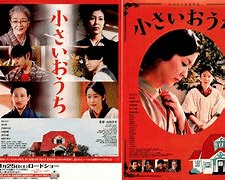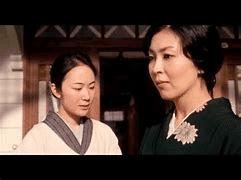
日本映画のあらすじと感想 日本語と英語で書いてみた
小さいおうち(2014)

82歳の山田洋二監督がメガホンをとった作品。主役のタキを演じた黒木華がベルリン映画祭で主演女優賞を受賞した話題作である。第二次世界大戦がはじまる前、まだ世の中が好景気に踊らされている時代、東京の郊外に赤い屋根の小さい家が新築された。まるで絵本の中から抜け出てきたような、モダンでかわいらしい家である。この小さな家で起こった出来事が東北から出てきたお手伝いの少女、タキの目を通して語られる。
晩年のタキ(倍賞千恵子)はアパートに一人暮らし。たまに甥の息子健史(妻夫木聡)がそれとなく様子を見に来てくれるのを楽しみにしている。タキが惚けてしまわないように、と健史は若いころの思い出を書くように勧める。そんな風にして書き始めた自分の過去だったが、思いがけず封印していた遠い記憶がよみがえってくる。
1936年上京したタキはおもちゃ会社の重役、平井家のお手伝いとして働き始める。平井家にはご主人と奥様の時子(松たか子)、小学校に上がる前の一人息子がいた。幼い少年はポリオを患い下肢が不自由だった。タキは美しく気さくでまだ年若い奥様時子に惹きつけられる。時子はタキが憧れる都会を象徴する存在だった。二人の間には単なる女主人とお手伝いの枠を超えた、女同士の友情が芽生えていく。
事件は家に会社の若いデザイナー板倉(吉岡秀隆)がやってきた時から始まる。タキと同じ東北出の板倉は「以前からこの家が大好きだったのです、ご縁ができてうれしいです」と言って繊細な感性で赤い屋根の家を称賛する。その穏やかで芸術家肌の板倉と美しい時子がひかれあうのに時間はかからなかった。恋に落ちていく二人、それをはらはらしながら見守るタキ。時代はやがて戦争へと進み、板倉にも召集令状が届く。小さい家を愛するタキと時子と板倉の運命の歯車は誰もが予想のつかない方向に回り始める。
山田監督は松たか子にひたすら色気のある演技を求めたという。観客がドキドキするような高揚感が描かれなければ、秘密の恋愛は密度が薄くなってしまうからだ。だが松たか子に色気を求める以前に、監督がなぜ吉岡秀隆を恋愛の相手役として選んだかに納得がいかない。吉岡秀隆の持つ独特の雰囲気、あの歯切れの悪いしゃべり方や、おどおどした物腰で時子のような女性を魅了することができるのか。山田ファミリーに欠かせない存在の吉岡だが、この作品にそのスタイルが生かされているとは思えない。
映画の最後には「許されない恋」を封印することになった70年前の出来事が描かれている。タキが忘れていた、もしくは忘れてしまおうとしたあの赤い屋根の家で起こった事件の切れ端である。
この場面がなければ、映画は締まりのないメロドラマになってしまうだろうから、大切なプロットではある。しかし、肝心の秘めた恋物語よりも強く前面にでているのは、戦争という暗い時代を背景に庶民がどのように日々を生きていたか、という細かい描写であり、昭和を愛する監督のノスタルジーである。この作品のテーマがどこにあるのか、映像の中に答えが見つからないように、恋物語の方も説得力が乏しいという気がしてならない。 タキが一人、死ぬまで心に重しを抱えて生きた、という設定もあまりに気の毒である。ただし、小さいおうちに象徴される昭和モダンの懐かしい雰囲気は、窓ガラスや調度品のひとつひとつにまでこだわりぬいた製作者の努力あって、見ていて非常に心を惹かれる出来になっている。

“The Little House” is a memorable film, shot by the eighty-two-year-old veteran director Yamada Yoji’. Kuroki Hana as Taki, a young maid won the Best Actress at the Berlin Film Festival. Both the
movie and Kuroki’s award became the topic of conversation.
Several years before the World War Two, people are leading their lives innocently, believing in prosperous future of Japan. The red-roofed little house stands on the top of a hill in the suburbs of Tokyo during this temporally peaceful period. The modern and eye-catching house looks as if it came out of a picture book. The story is punctuated by voiceover of Taki in her latter days (Baishyo Chieko) “And then・・” , and shifts between the 1930s and the period before her death.
In her latter days, old Taki lives alone in an apartment house, looking forward to the visits of her grandnephew Takeshi (Tsumabuki Satoshi), who casually drops in to see how she is doing. He encourages Taki to write her reminiscences for the purpose of preventing dementia, and once in a while he reads her story and offers some advice. Unexpectedly, this simple activity awakes Taki’s long buried memories. Her mind jumps back to 1936, when the young Taki leaves her hometown in the rural northern part of Japan, and starts working as a maid for a toy manufacturer Hirai family. She works hard not only doing house chores but also taking care of the couple’s little boy who suffers polio. Her devotion earns the family’s gratitude and trust. Taki has been attracted by Hirai’s young and beautiful wife Tokiko (Matsu Takako) as a symbol of sophisticated urban elegance ever since she first met Tokiko. Before long, Taki feels a special tie between them, both as a faithful servant and as a soul companion.
The story starts churning with the arrival of Hirai’s junior worker Itakura(Yoshioka Hidetaka). The promising young designer, who is also from northern Japan, sincerely expresses how much he admires the little house and his pleasure of being invited to the house as a guest. His amiable sensitiveness is welcomed by the family, especially frank and friendly Tokiko. What will happen is predictable. Taki observes in silence her mistress’s emotion toward the young man supplanted with a passionate love behind the back of her husband . Over time, the negative effects of war come to be felt in their lives. Itakura receives a call-up notice and they eventually break up.
Yamada Yoji strongly demanded Matsu Takako to play a seductive woman. Without her sexual attractiveness, the film may have ended up like a nursery tale unfolded in the little house. The Audience expect to taste the thrill, watching their hidden intimacy. This is one of the most important factors in the film, so I wonder why Yamada Youji chose Yoshioka Hidetaka as her lover? Did Yamada really believe that women fall in a person with a dull-talking and nervous-rabbit- looking man? Yoshioka is certainly a regular member of the Yamada movies, but I hardly find any essence of passionate love in his character
At the end of the movie another secret is disclosed after these seventy years, which thwarts Tokiko’s last meeting with Itakura. Old Taki has forgotten, or tried to forget, about what she had done to her mistress but it has remained in her inner mind as a residue. This final scene renders a significant impact on the whole story; otherwise it would have ended up like a sloppy soap opera.
Yamada Youji must have wanted to depict a love affair in a discreetly twisted way, but it is not elaborated enough to convince us of its inevitability. I rather feel stronger empathy to the detail about how people live under the pressure of the World War II , and Yamada’s nostalgic emotion toward the Syowa era.
The set design and authentic details are fabulous. We can feel the atmosphere of Syowa-modern there in the props such as mosaic window glasses, lamp-shade fringes and tea cups, which are at least worth watching No one would undervalue the creator’s effort.
